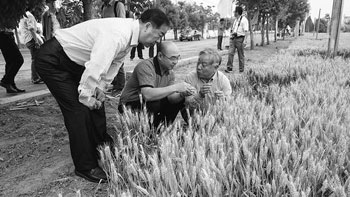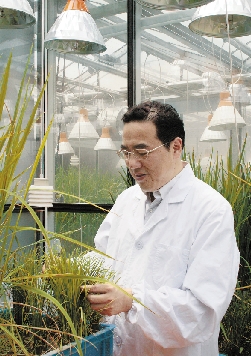Water-saving technology planting wheat on demand set up invincible
Original title: technology Integration to improve the Competitiveness of Wheat Industry

The expert is in the field to check the growth of wheat. Photo taken by Li Chen
In a few days, the 3300 mu wheat field of Sanxing Family Farm in Daguan Town, Fengquan District, Xinxiang City, Henan Province will be harvested. Farmer Fan Haibao is very confident about this year's wheat harvest. He told China Science Daily: "Last year, we began to adopt the sprinkler irrigation water-saving technology of the Chinese Academy of Agricultural Sciences, which saves 40 cubic meters of water by watering once less; at the same time, we adopt the technology of unified pest control and one less dose of medicine. Save 30 to 50 yuan per mu. Moreover, the yield per mu of that year has increased from more than 400 kg in the past to more than 500 kg. "
The two technologies mentioned by Fan Haibao are the Institute of Science, Irrigation, Plant Protection, Information Planning, processing, and Agricultural Mechanization of the Chinese Academy of Agricultural Sciences, together with the Wheat Research Institute of Henan Academy of Agricultural Sciences, Xinxiang Municipal Academy of Agricultural Sciences, Xinxiang Municipal Bureau of Agriculture, and other units to form a collaborative research team to integrate a set of green production-increasing and efficiency-increasing technologies for the wheat industry. This year, his family farm adopted all seven integrated technologies, becoming a demonstration site for the project.
After an on-site inspection, Chen Mengshan, secretary of the party committee of the Chinese Academy of Agricultural Sciences, told the China Science Daily that technology popularization and socialized services are important factors that determine China's stable wheat production, saving labor and reducing labor intensity. "in the process of grasping wheat production, we found that scientific and technological progress plays a very obvious role in promoting the development of wheat industry."
Only the integrated technology can realize water saving.
"only by integrating the seven technologies can we achieve water saving in wheat production." Xiao Shihe, a researcher at the Institute of crop Science of the Chinese Academy of Agricultural Sciences and chief scientist of the wheat industrial technology system, stressed to the China Science Daily that the application of one or two water-saving technologies can not achieve the goal of water saving.
The seven integrated technologies include: water-saving and high-quality wheat varieties, wheat standardized precision sowing technology, wheat moisture measurement, supplementary irrigation and water-saving technology, wheat soil testing formula reduction application technology, wheat disease, pest and weed prevention and control technology, wheat mechanization production technology, wheat quality analysis and monitoring technology. Xiao Shihe explained that taking the first technology as an example, the water-saving performance of different wheat varieties varies greatly, so it is necessary to select water-saving varieties according to planting needs; when precision sowing, we should comprehensively consider whether it is better to save water in some places or to save seeds; and after measuring soil moisture and supplementary irrigation, we can reduce one watering and save 40 cubic meters of water.
It is reported that the project has established a technological R & D and promotion platform of "scientific research institutions + local governments + enterprises + farmers", which combines production, learning, and research, and gives full play to the overall advantages of the combination of scientific research institutions, local governments, and enterprises. in accordance with limited objectives, highlighting key points, unified design, division of labor and cooperation, coordinated tackling key problems and key breakthroughs.
Among them, the integrated and innovative "Huang-Huai-Hai wheat mechanization production technology" and "wheat main pest control technology" have been released by the Ministry of Agriculture as the technology promoted by farmers throughout the country, playing an important guiding role in the national wheat production.
Change the thinking of scientific research from the demand side
"Technology integration and support have changed the way we used to look at things with technology. This time is completely different, according to the needs of users to assemble the technology. " Xu Weigang, director of the Wheat Research Institute of Henan Academy of Agricultural Sciences, told China Science Daily.
According to Xiao Shihe, the main technology on display this time is to integrate the technical models needed by different production organizations according to the needs of new production organizations and according to the three organizational forms of government organizations, farmers' cooperatives and professional farmers. it provides a direct and practical technical scheme for the development of wheat production in the future.
"according to the actual needs of new production organizations, the latest production technologies are integrated and provided directly to different production organizations, which not only improves the promotion of improved varieties and methods, strengthens the technical content of wheat production, but also helps farmers to steadily increase their production and income. economic benefits have increased steadily, and industrial competitiveness has been gradually improved." Xiao Shihe, for example, in Funing Market Town, Yuanyang County, Henan Province, according to the idea of promoting the establishment of high yield in the whole township, integrated the new technology of "water-saving, fertilizer-saving and medicine-saving" in wheat production, including fine soil preparation, standardized sowing, water-saving (measuring soil moisture and regulating deficit) irrigation, soil testing and formula fertilization, "one spray and three prevention" during the filling period, and other scientific and technological achievements, on the basis of high and stable yield, improve the efficiency of resource utilization.
In Dagan Town, Fengquan District, Xinxiang City, according to the needs of supporting family farms, promoting production cooperatives, and improving production efficiency, technologies such as new variety breeding, water-saving irrigation, whole-process mechanization, and unified prevention and control of diseases and insect pests are integrated. With 1000 mu of Zhengmai subfields of Sanxing Family Farm, 12000 mu of wheat from the Green Leaf Farmers' Cooperative will be promoted to achieve improved varieties and increase production and income.
In Jitun Town, Hui County, Xinxiang City, through the Wufeng Grain Cooperative and surrounding farmers to sign a contract for the purchase of 30000 mu of Xinmai 26 wheat with high quality and high price, according to the nutritional needs of strong gluten wheat, provide fine soil preparation, standardized sowing, water-saving (measuring soil moisture and regulating deficit) irrigation, soil testing formula fertilization, nitrogen fertilizer backward and other high-quality wheat production integration technology to drive farmers to increase production and income. The recovery price of wheat in 2016 was 0.4 yuan / kg higher than the market price, which alone increased the income of farmers in this town by 1.28 million yuan.
How to maintain the International competitive advantage of Wheat
Henan Province has a wheat planting area of 80 million mu, ranking first in the country. "I have been in office for less than half a month, and this is my second visit to Henan." Liu Chunming, director of the Institute of Scientific Research of the Chinese Academy of Agricultural Sciences, told China Science Daily that China has the second largest germplasm bank in the world and has very strong breeding strength. "however, it is impossible for a single unit to solve the grain problem well, and it is necessary to unite with local scientific research institutions. The gap between us and foreign countries lies in the use of various technologies. "
This is also a point that Chen Mengshan repeatedly emphasized to the members of the project team.
At present, the international trade volume of wheat in the world is 160 million tons, while the output of wheat in China is 130 million tons. Among the top 10 major wheat suppliers in the world, China has the highest per unit yield, reaching 5200 kg per hectare in 2015, which is 3288 kg higher than the world average at the same level and 50 per cent higher than that of the United States. "the level of per unit yield shows our scientific research level of wheat." Chen Mengshan said. However, over the past 50 years or so, there has been a slight surplus in the global wheat supply and demand in the bumper year, and a slight shortage in the underyear. If the general trend of international trade changes, it is possible to upset the political balance. "this risk is very great," Chen Mengshan points out.
At the same time, China's wheat rations are mainly used to make noodles and steamed bread, which is different from the varieties required by wheat mainly used as bread in western developed countries. "it is also impossible to meet the special needs of our domestic consumption by relying on the international market." Chen Mengshan said: scientific research departments and production management departments should firmly bear in mind that maintaining the domestic quality of wheat is not only China's national conditions, but also an important place for us to implement national security in the new century.
To this end, Chen Mengshan suggested: "it is necessary to increase collaborative innovation and integrated innovation, and to form an aircraft carrier for national wheat scientific research." There are more than 500 wheat scientific research teams in China, with a lot of investment at all levels, repeated crossover, unmatched top and bottom, unreasonable allocation of resources, and caused a lot of waste. "in order to break through the problems of industrial development and scientific and technological bottlenecks of wheat, it is very difficult to rely on a single variety and one-way technology, so now it is necessary to carry out agronomic matching of agricultural machinery, including the comprehensive technical solution of the whole wheat. it is necessary to carry out technology integration and coordinated research on key problems, and establish a model of high-yield and high-efficiency technology." Chen Mengshan said. (our reporter Li Chen)
- Prev

The farmer's father climbed dozens of meters in the air, and his father really loved him like a mountain.
The farmer's father climbed dozens of meters in the air, and his father really loved him like a mountain.
- Next

Chen Jianping plant virus meets nemesis in micro world
Chen Jianping plant virus meets nemesis in micro world
Related
- A course of planting techniques and methods on how to grow carrots
- How to plant the latest tulips?
- Is it better to pick tea in the morning or in the afternoon? When is the best time for tea to be picked? what is the third or fifth tea?
- Launch Yuanxiao Happy combination Haocha + Tea Yuan healthy Taste
- Penghu Tourism "Fireworks 20 Parade with You"
- 2022 West Lake Happiness holds "Digital Revitalization Voucher" and draws iphone13 and laptop.
- Banqiao Fuzhou social houses are designed to change start-up combined with police elimination to create a safe and livable environment
- The convenient measure of "mechanical weeding" in Xinbei has been abused and the Agriculture Bureau has imposed heavy penalties on the illegal land consolidation.
- Changgeng University Joins Hands with Four Memory Factories to Rescue Memory Talent Shortage
- The list of Taiwan's top 100 MVP managers is listed by the Director-General of the Farmers' Association of Sanxia District.

